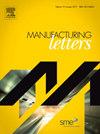Evolution of microstructure and mechanical property enhancement in wire-arc directed energy deposition with interlayer machining
IF 1.9
Q3 ENGINEERING, MANUFACTURING
引用次数: 0
Abstract
Wire-Arc Directed Energy Deposition (Wire-Arc DED) has emerged as a promising additive manufacturing technique known for its high deposition rates. However, the variability in microstructure and mechanical properties (e.g., hardness) of the manufactured components poses significant challenges. This study delves into these issues, focusing on the influence of interlayer machining on the microstructural evolution and mechanical properties of thin-wall Wire-Arc DED structures. It is shown that as-built Wire-Arc DED structures exhibit a pronounced microstructure variation between different regions along the build direction, primarily governed by the differences in thermal history. In contrast, a Hybrid Wire-Arc DED process that integrates interlayer machining into the build process to induce severe plastic deformation leads to a microstructure characterized by refinement and homogenization, compared to a Wire-Arc DED process. This study provides insights into the impacts of plastic deformation due to machining and thermal cycling due to subsequent layer depositions on the microstructure and hardness obtained in Wire-Arc DED and Hybrid Wire-Arc DED processes, highlighting the potential of hybrid manufacturing to generate tailored microstructures to enhance the mechanical performance of functional components.
带层间加工的线弧定向能沉积的微观结构演变和机械性能提升
线弧定向能量沉积(Wire-Arc DED)以其高沉积率而闻名,已成为一种前景广阔的增材制造技术。然而,制造部件的微观结构和机械性能(如硬度)的可变性带来了巨大挑战。本研究深入探讨了这些问题,重点研究了层间加工对薄壁线弧 DED 结构的微观结构演变和机械性能的影响。研究结果表明,坯料线-弧 DED 结构在沿坯料方向的不同区域之间表现出明显的微观结构差异,这主要受热历史差异的影响。相反,与线弧 DED 工艺相比,混合线弧 DED 工艺将层间加工集成到构建过程中,以诱导严重的塑性变形,从而导致微观结构以细化和均匀化为特征。本研究深入探讨了机加工引起的塑性变形和后续层沉积引起的热循环对线弧 DED 和混合线弧 DED 工艺获得的微观结构和硬度的影响,凸显了混合制造生成定制微观结构以提高功能部件机械性能的潜力。
本文章由计算机程序翻译,如有差异,请以英文原文为准。
求助全文
约1分钟内获得全文
求助全文
来源期刊

Manufacturing Letters
Engineering-Industrial and Manufacturing Engineering
CiteScore
4.20
自引率
5.10%
发文量
192
审稿时长
60 days
 求助内容:
求助内容: 应助结果提醒方式:
应助结果提醒方式:


